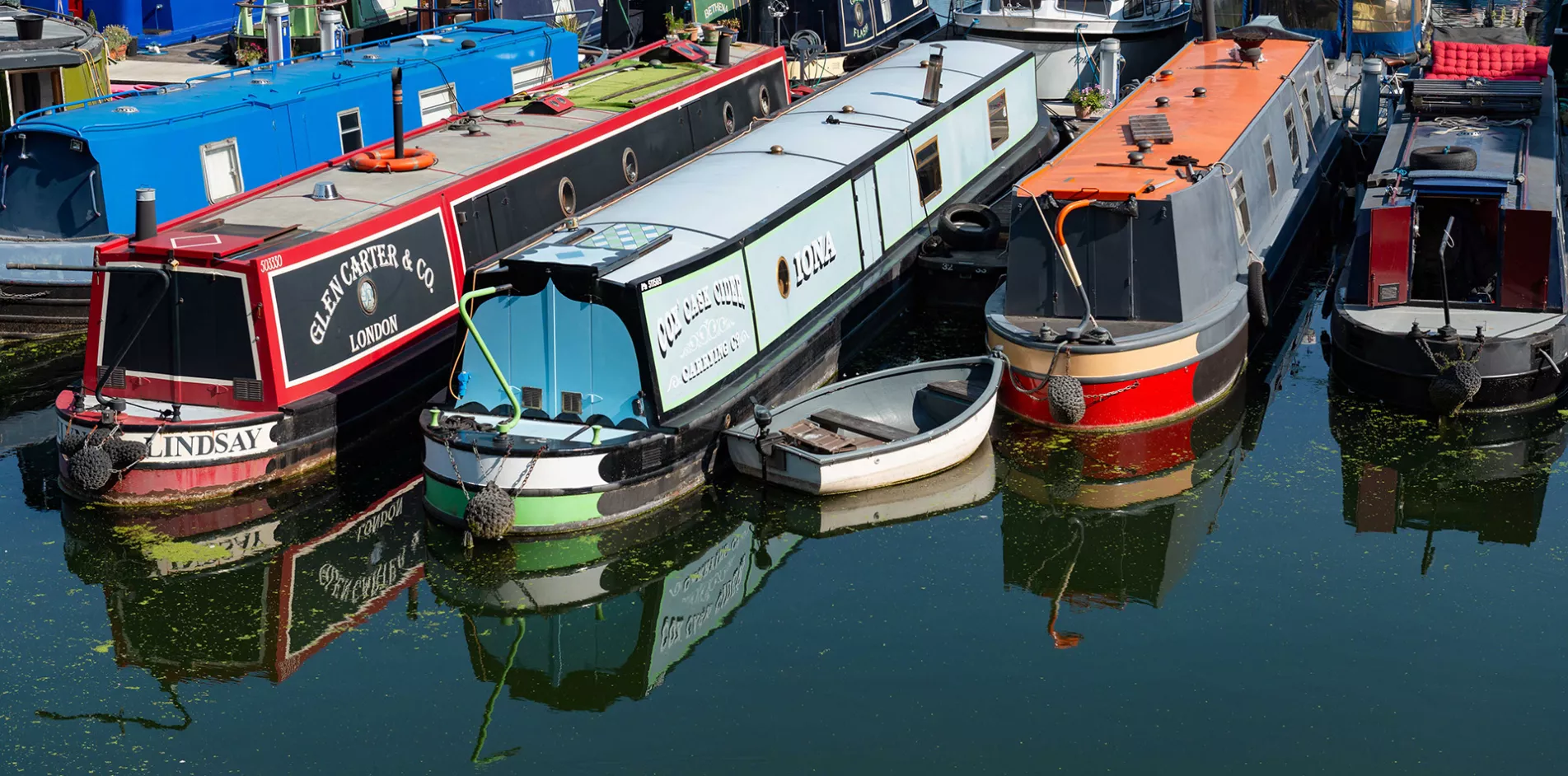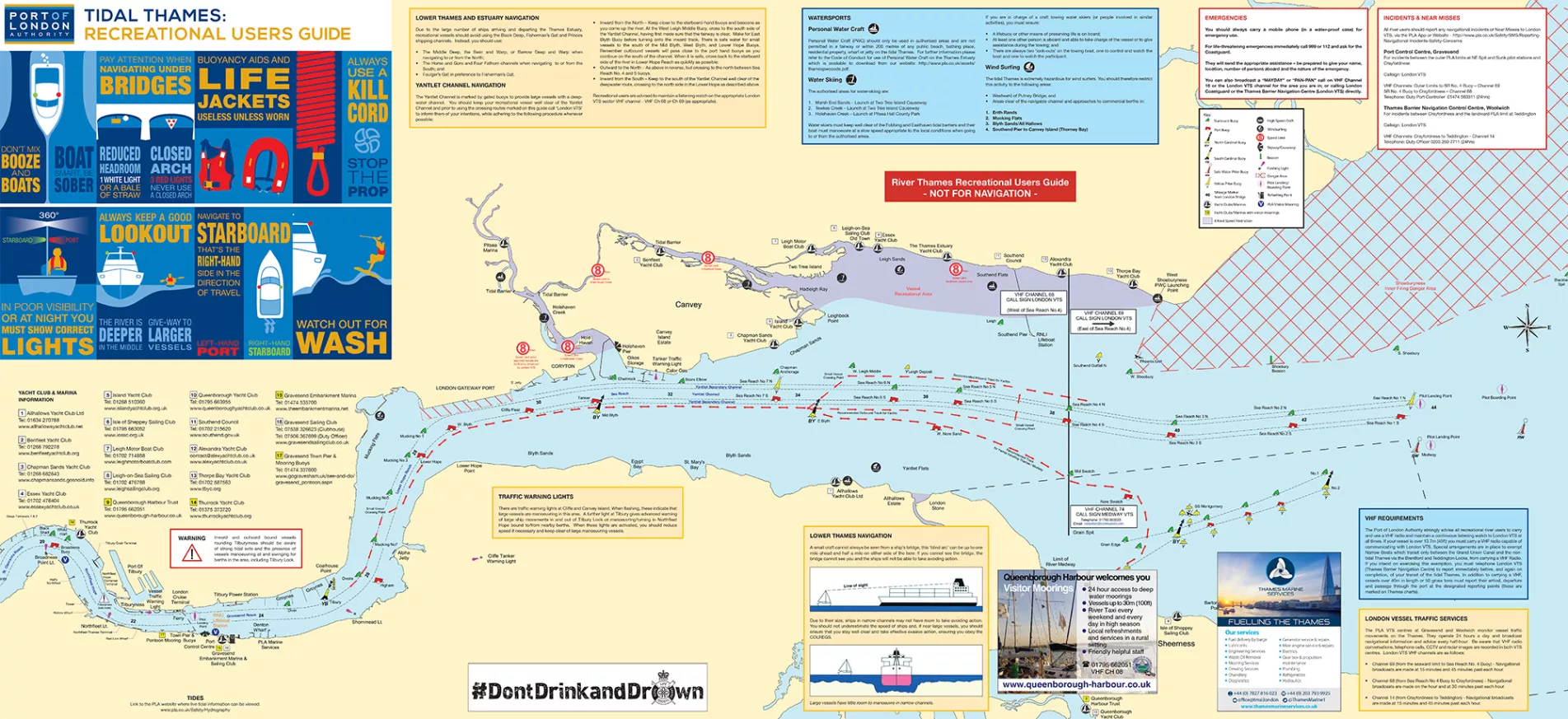Live Tides
NOTICES TO MARINERS
Charts & Surveys

Incident reporting
Life-threatening emergencies on the river:
Call 999 and ask for the Coastguard
For near miss, safety observations and incident reporting click below

Narrow Boating
Narrow boating on the tidal Thames presents a unique set of challenges, but a rewarding experience
Safe passage requires a sound knowledge of the effects of the tidal stream, including the resultant currents and variable depths which are not found on the (non-tidal) canal system.
The Passage between Teddington and Limehouse is only recommended for the experienced boater, as waves over a metre in height and tidal flows in excess of four knots can be encountered.
The following information is provided as a guide. Remember, the responsibility for the safety of any vessel and for compliance with all regulations remains with the person in charge of the narrowboat (The Master).
Narrowboats of 13.7m or more in Length Overall require a VHF radio. However if you are only navigating between Brentford and Teddington, you are exempt from this requirement.
There is a further exemption for narrowboats travelling west of Bow Creek, provided that you are travelling in a flotilla. When travelling in a flotilla then only the ‘lead vessel’ is required to carry a VHF radio. If using this exemption, it is important that all narrowboats in flotilla have a means of contacting the lead vessel such as a mobile phone.
TIP! We always advise carrying a VHF radio regardless of narrowboat size or any exemptions. It is a valuable piece of equipment that be a lifesaver in an emergency.
If you are travelling from Limehouse (or any other location east of Brentford) to Brentford or Teddington, your vessel must have a working VHF radio.
The VHF exemption only applies when travelling between Brentford and Teddington.
Between Crayfordness and Teddington you should listen to VHF Channel 14. London VTS regularly broadcast useful information which may be relevant to your voyage.
Remember that as you progress further upriver, especially above Putney Bridge, radio signals can get ‘patchy’ and you may not be able to clearly contact London VTS.
TIP! You should keep a charged mobile phone close by with London VTS’s telephone number saved in your contacts. (London VTS - 0203 260 7711)
Yes. Thames Byelaw 18 requires that a narrowboat be equipped with at least one suitable anchor with chain, cable or rope. The anchor must be available at all times for immediate use.
Remember that an anchor is like a car’s brake, in an emergency such as engine failure, you may need to use it to stop your narrowboat drifting away uncontrollably.
TIP! Check your chart for ‘no anchoring zones’’!
As the tidal Thames is linked to the sea, all narrowboats operating (between sunset and sunrise) on the tidal Thames must comply with the requirements of the Collision Regulations, specifically Part C – Lights and Shapes; Rule 23 – Power-driven vessels underway.
A power-driven vessel underway shall exhibit:
a masthead light forward
sidelights;
a sternlight.
If your narrowboat is less than 12m Length Overall, you may exhibit in lieu of (a):
an all-round white light and sidelights
Private narrowboats do not require any form of permit of license to navigate recreationally on the tidal Thames. However, you may require a permit from the Canal and River Trust or the Environment Agency to operate on the Grand Union Canal or above Teddington Lock.
Thames Lock (Brentford) / Limehouse Lock / Bow Lock / West India Dock
These are owned / operated by Canal and River Trust (CRT) and full details on how to book a lock transit can be found here.
Teddington Lock
Teddington Lock is owned and operated by the Environment Agency, is staffed 24/7 and can be contacted on 0208 940 8723.
Richmond Lock and Half Tide Weir
Richmond Lock is owned and operated by the Port of London Authority is staffed 24/7 and does not require a booking. A fee is payable if using the lock. However, for around 2 hours either side of high water, the weir sluice gates are raised allowing free passage of vessels. If possible, schedule your transit to pass through during this time. The PLA Lock keeper can be contacted on 0208 940 0634.
TIP! When planning your voyage write down (on paper) all the contact numbers required for any locks or marinas you will use, just in case of any technical issues!
Travelling through Central London is not for the light-hearted or inexperienced boater. It is a busy watercourse with large passenger vessels, commercial tug and tows, RHIBS and water-ferries operating.
There are specific rules (General Directions and Byelaws), navigational lights on bridges and of course the collision regulations that must be followed. In addition you will also encounter many bridges, piers and shoals that will need to be navigated safely.
It is highly recommended to speak to experienced boaters who know the tidal Thames and if possible, find someone to come aboard and advise you on your first time navigating through central London.
General advice:
Create a passage plan – a step by step guide that you will follow from start to finish. It should include as a minimum: which arch you will take at each bridge, contact details for any locks or marinas you will use, possible safe moorings if you need to stop, and the tide heights for each stage of your journey.
Check all of your vessel’s equipment prior to entering the tidal Thames. This should include the engines and steering mechanisms, check your anchor is ready for emergency, VHF radio and navigation lights.
Carry up to date navigation charts.
Listen to VHF Channel 14 for London VTS who regularly broadcast useful information including large vessel movements and current tide heights.
TIP! Do your homework, plan your voyage, check the weather and tides and never underestimate the tidal Thames.
Any person seeking to hire a narrowboat for use on the tidal Thames should ensure that the narrowboat owner is licensed and registered with the PLA. If they cannot provide proof that they have registered with the PLA, the company may be untrustworthy and may not meet safety standards. You should proceed with caution before booking.
The PLA publishes many useful documents that you should consider before boating on the tidal Thames:
If you have any further queries, please get in touch with the Harbour Master team at: [email protected]
Thames map
Information about yacht clubs, rowing clubs, marinas, moorings and other facilities for leisure boaters and sports participants on the tidal Thames.
Discover




